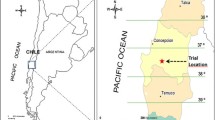Abstract
Mathematical models utilizing average Calendar date, geographic parameters, and accumulated soil and/or air heat units were tested for predicting the date of leaf emergence ofSyringa chinensis, CV Red Rothamagensis, lilac. Forty five sets of data, from 7 locations in New York state, were used. A model accumulating daily heat units above a base temperature of 5.5°C, gave the best prediction, with a standard error of ± 6.0 days.
Regional research projects NE-35 and NE-69 have collected dates of first leaf and three stages of bloom for the Red Rothomagensis lilac since 1965. Data from approximately 300 sites were reported by Hopp, Blair and Hickin (1973). Hopp and Blair (1973) developed models to predict the average date of the lilac phenological events based on latitude, longitude and elevation. Models using only geographic input do not have the capability to predict the year to year variations that occur in spring development of perennial plants. Early and late biological springs are associated with variations in the weather. Such factors as air temperature, solar radiation, precipitation, soil temperature and wind all have an effect on the environment sensed by the plant, and thus may influence the rate of development.
A common method of predicting a spring phenological event is by accumulating heat units above a given base temperature. This proved to be useful for predicting maturity of seeded crops when accumulations are started on either the day of planting or the date of seedling emergence. There is no seeding date from which to start heat unit accumulations for perennial plants emerging from winter dormancy. Thus, the problem of evaluating the base temperature is compounded by variability introduced when different start dates are used. The first phenological event to be observed in the spring is the main one to present the problem of start date variation. This event can be used as a base line for predicted subsequent events from heat unit accumulations.
This study is concerned with the emergence of the first leaf of the Red Rothomagensis lilac. This event, as defined by Hopp, Vittum and Canfield (1969) is "the date when the widest part of the newly emerging leaf has grown beyond the ends of its opening winter bud scales". We evaluated mathematical models utilizing soil and air temperature for predicting the first leaf phenophase.
Similar content being viewed by others
References
ANONYMOUS (1968–1974): Monthly meteorological summary. Vol. 4–10. Division of Meteorology. Department of Agronomy, Cornell University.
HOPP, R.J. and BLAIR, B.O. (1973): Plant phenology in eastern and central North America. I. Development of networks and preliminary results. Vermont Agr. Exp. Sta. Bull. 677.
HOPP, R.J., BLAIR, B.O. and HICKIN, R.P. (1973): Plant phenology in eastern and central North America. II. Phenological observations on lilac Red Rothomagensis. Vermont Agr. Exp. Sta. Bull. 678.
HOPP, R.J., VITTUM, M.T. and CANFIELD, N.L. (1969): Instructions for phenological observations: Persian lilac. Vermont Agr. Exp. Sta. Pam. 36.
PARTRIDGE, N.L. (1947): A method for the estimation of the advancement of vegetation by use of daily maximum temperatures. Proc. Amer. Soc. Hort. Sci., 49: 7–14.
Author information
Authors and Affiliations
Rights and permissions
About this article
Cite this article
Hickin, R.P., Vittum, M.T. The importance of soil and air temperature in spring phenoclimatic modelling. Int J Biometeorol 20, 200–206 (1976). https://doi.org/10.1007/BF01553662
Issue Date:
DOI: https://doi.org/10.1007/BF01553662




